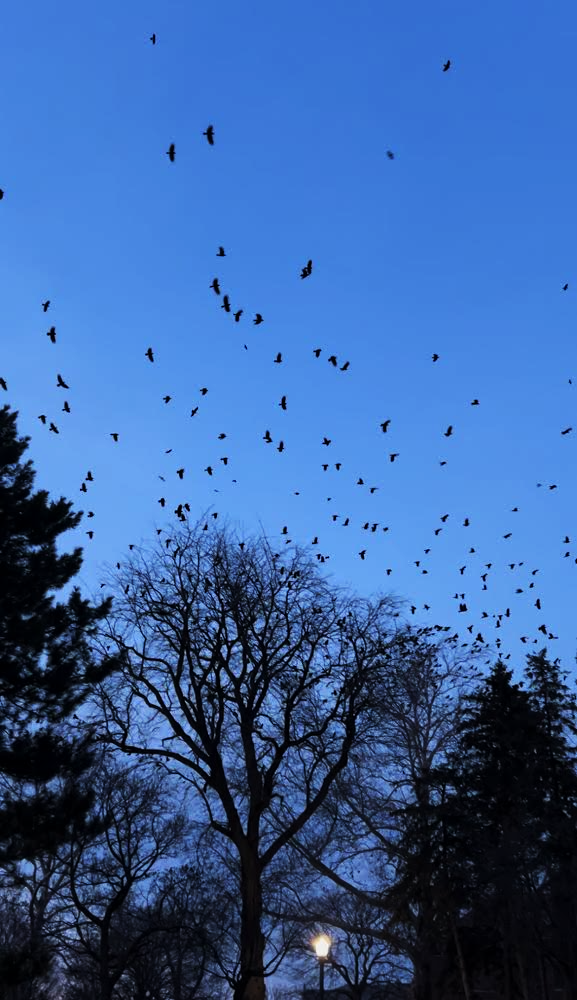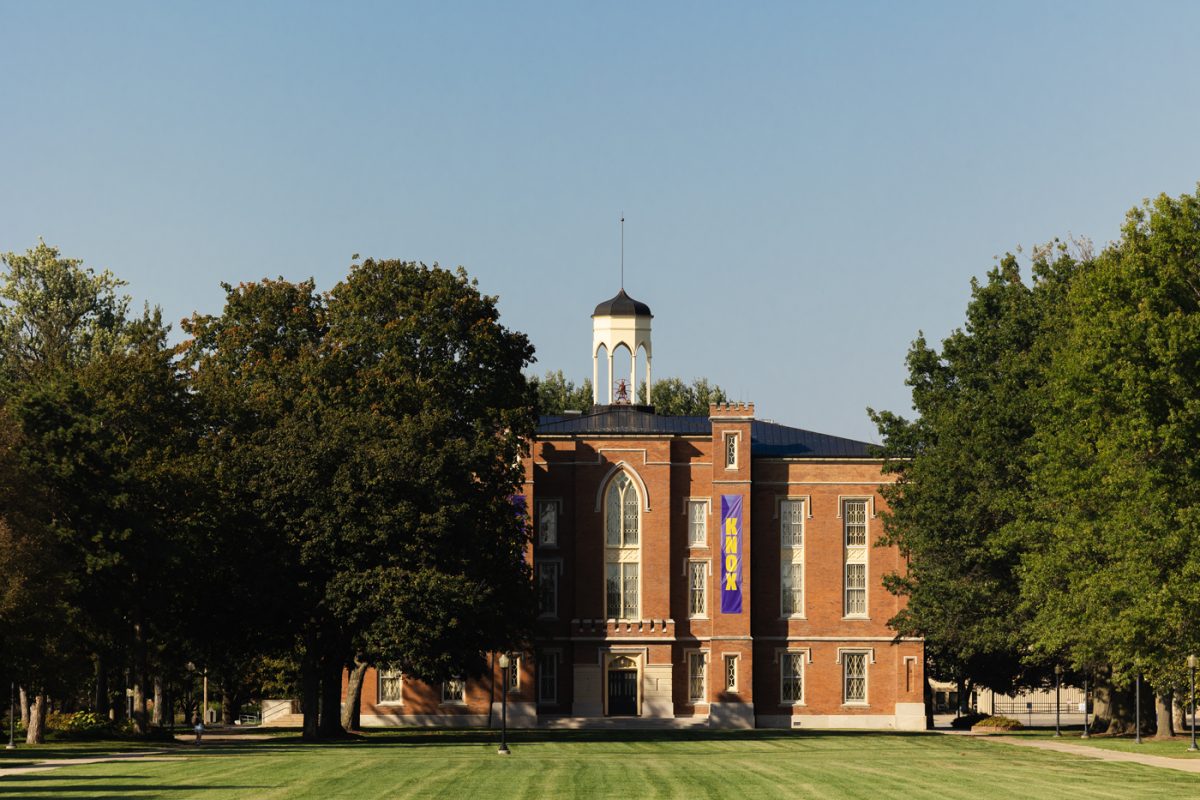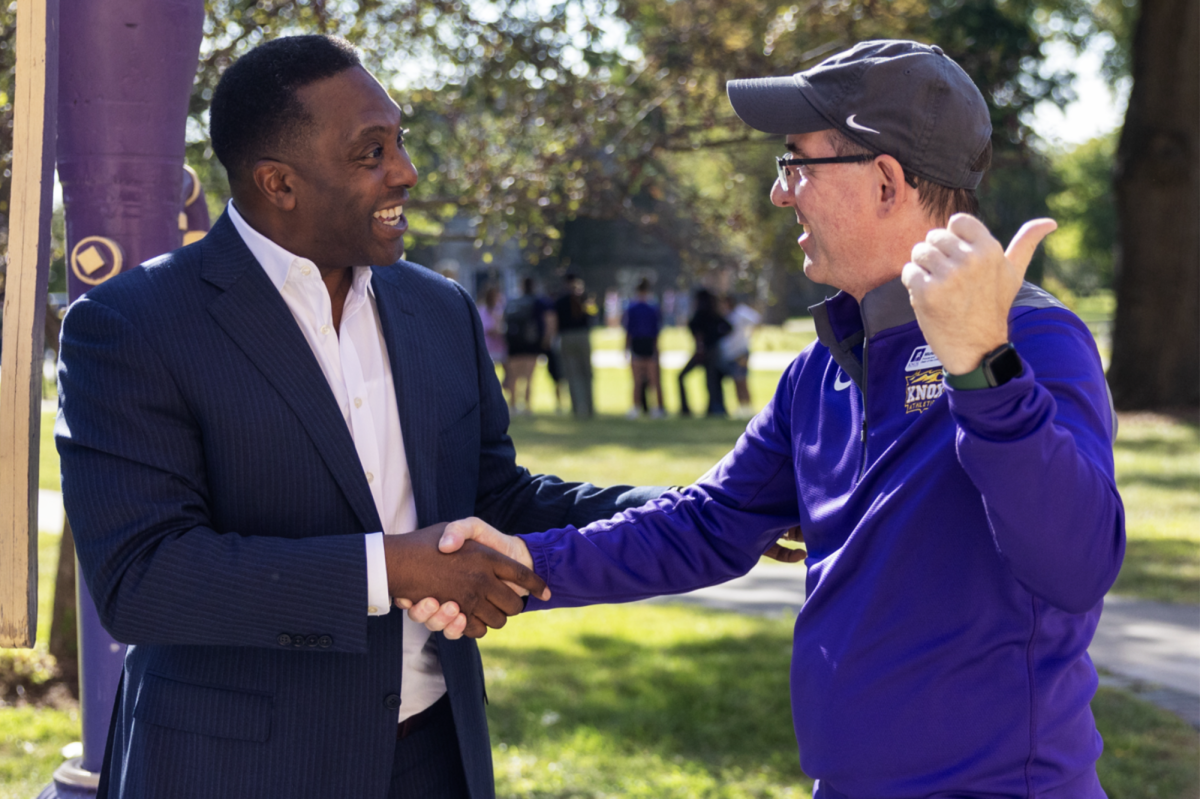Galesburg winters include the rhythmic sounds of hundreds of crows circling the trees at sunset.
On the Knox campus, the trees between GDH and Old Main are especially crowded with crows returning to their roosts for the night. Some years, they also swarm the trees near SMC and Post.
Ornithology professor Jim Mountjoy has observed the crows since he came to Knox in 2001 and thinks they have been in Galesburg long before that, too. Their exact roost sites vary from year to year, but he said the Knox campus, Hope Cemetery, Standish Park, and the courthouse area are frequented by the crows.
He said crows roost in the same general area they were raised in, which is why they keep returning every year.
During the day, the crows fly to the surrounding cornfields.
“Corn is very important in the diet, and the fact that we have so much corn growing around here, and so much gets left in the fields after harvest, that’s the reason why we can support a huge population of crows in the area,” Mountjoy said.
They may scatter in smaller groups during the day, but they return to the city together at night.
“What you will see is that once you get into the later afternoon, they start moving back towards the roost,” Mountjoy said. “But they stop and often gather together in groups before coming all the way into the city. So you’ll see flocks just sitting in cornfields or in some of the trees, and then those pretty large groups will move in as it gets closer to sunset.”
The reason they prefer to roost downtown? Mountjoy said crows prefer cities because they are slightly warmer at night than less populated areas, and there are typically fewer predators, such as the great horned owl.
With large numbers of crows flying overhead nightly in winter, director of grounds Brad Bergren said it is difficult to deal with the mess of droppings they leave behind.
“The crows are definitely a nuisance,” Bergren said.
When the temperatures are high enough, grounds workers use power washers to clean the sidewalks, but for a few weeks in January, it was too cold and snowy to do so. When it is too cold to use water, grounds workers use brooms.
This winter, though, they have power washed the sidewalks more than usual, though Bergren noted that is because of the warmer temperatures in December and February, and not necessarily that the crows are leaving a bigger mess this year.
“We don’t do anything to harm them by any means; we just clean up after them,” Bergren said.
As much as the crew cleans, however, the mess just returns with the crows, which takes time away from workers’ other tasks.
“Our experience is, they’re pretty much going to do whatever they want,” Bergren said. “I wish I could figure out a way to keep them away.”
Others have tried different methods of getting rid of the crows.
Elena Prado-Ragan, ‘18, researched if crow effigies—models of crows she hung in trees—could deter crows from certain areas. Mountjoy said that the crows could tell that the models hung right-side-up were not real, but they did seem to be scared off if the effigies were hung upside down, as if dead.
Mountjoy said that some buildings downtown have played crow distress calls over the years.
“Crows are very intelligent birds, and they certainly will get accustomed, habituated to things like repeated playback of the same sound over and over again,” Mountjoy said. “Things like gunshots and such can be effective, but it also is pretty disturbing to the people, a lot of this noise and limited effectiveness.”
Mountjoy said the city has also tried flashing lights in the past. A TKS article from Feb. 2010 describes a man called the “crow whisperer” being hired to get rid of them, which was somewhat effective, but he would not reveal his secrets.
Mayor of Galesburg and Professor of Environmental Science Peter Schwartzman said he does not know of any current actions being taken by the city to remove the crows.
Mountjoy said their numbers will likely start decreasing as more crows return north to Canada around mid to late February, but some will probably stay until March.
He said that there is still much to learn about crows and what their different sounds mean.
“Even though it’s a really common bird, we actually don’t know that much about crows and their behavior because they’re difficult to study because they’re too smart,” Mountjoy said.
For example, crows can recognize human faces, he said. Crows will get upset when they see humans that they dislike or that have messed with the crows before.
They have also been found to use tools, one of the few animals to do so.
Crows are social, Mountjoy said, because it helps them avoid being picked off individually by predators. They also form family groups, where young and old crows often help a pair raise their young.
“Crows have been considered pests, and they’re often shot and hunted. Their impact on humans, for what that’s worth, is more complicated,” Mountjoy said. “They can have some damage to crops, but they can also have some benefits. They eat a lot of grasshoppers and get the grubs of beetles from the ground in summer, so they can have some positive effects on agriculture as well.”
They also inspire people’s art, as this TKS article from Feb. 2013 describes.
Schwartzman said an important question we as humans should ask ourselves is if we are going to try to live against the crows or in harmony with them.








